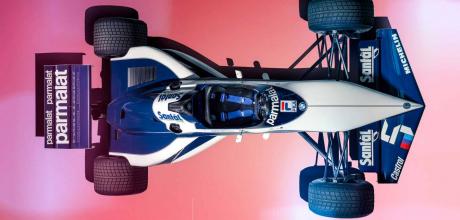1983 Brabham BT52
The truth is reliably stranger than fiction, and with the near-mythical motor BMW M built for Gordon Murray’s extraordinarily neat BT52 Formula 1 racer there’s almost as much strange fact and fiction as there was boost. (And there was a lot of boost.)
FROM FAMILY CAR TO F1 BRABHAM BT52 (1983)
Two great myths circulate regarding the methods M deployed to toughen up the engine for its unlikely redeployment from humdrum road-car life to the turbocharged bombast of F1 in the ’80s. (The M12/13 engine was a motorsport evolution of the humble 1499cc four-cylinder M10 road-car engine, designed in the ’50s and introduced in the early ’60s with the Neue Klasse cars so fundamental to BMW’s success and expansion – over 3.5 million M10 engines were produced.) Given early M10 engines were good for 70bhp, no wonder 1400bhp on qualifying boost (calculated – the M division dyno tapped out at 1200bhp…) through ostensibly the same engine proved structurally challenging.
Tougher blocks were needed. One legend has it that the cast-iron blocks were left to mature out in the weather on the factory roof, the lightly industrialised wind and rain of ’80s Munich enhancing the metallurgy. Another builds on the first to suggest that BMW workers with full bladders were sent to the aforementioned roof to relief themselves upon the engines, so that the wondrous properties of their potent urine might fortify the metals for punishment via vast KKK turbo and Nelson Piquet’s right foot. (The science is encouraging: as urea breaks down it produces ammonia, which contains nitrogen, which in turn is key to the metal-hardening process of nitriding.)
Sadly neither is true, according to Group Classic archivist Rainer Wenleder. But the truth is stranger still. ‘When they developed the M12 engine for F1 all the stress and the heat was cracking the blocks. These were new blocks straight from the factory, of course. But when they built up race engines with used blocks the problem disappeared. So, what they did initially for the F1 engines was to buy used cars – Neue Klasse cars like the 2002 – and strip out the blocks, which of course had experienced many heat cycles, for the F1 engines. Then ultimately they worked out how to heat-treat the engine without having to buy pre-owned ones.’
No miracle pee, then. Just a few innocent BMWs being bought second- or third-hand, stripped down and, a matter of weeks after their engines were trundling the school run, perhaps, or doing duty on a family day out to the mountains, the blocks were pushing out 1400bhp between the guard rails at Monaco…
Created in a matter of months following a late rule change, the dart-shaped BT52 used the BMW four-cylinder for sound, very Gordon Murray reasons. With fewer moving parts (four cylinders, 16 valves and one turbo, as opposed to the six cylinders, 24 valves and twin turbos of rivals Renault and Ferrari), the M12 generated far less friction and heat, which in turn allowed for the tiny radiators and sidepods so fundamental to the 52’s low-drag philosophy.
The BT52 and its BMW powerplant were a gamble, but they paid off. Piquet and the BT52 won three races and the title in ’83, stealing the first turbo drivers’ title from Renault despite all the French company’s trailblazing work with turbos in F1. And it did so with an engine that couldn’t have been more M division – powerful, good to drive, created for the road but ruthlessly effective on the track – if it tried.
Derek Warwick on the M12 turbo: ‘You couldn’t throw gears at it fast enough’ Yep, it definitely has a turbo
TECHNICAL DATA 1983 BRABHAM BT52
Humble road-car engine gets the F1 call-up. Wins the first turbo title
- POWERTRAIN 1499cc 16v turbocharged four-cylinder, five/six-speed manual, rear-wheel drive
- PERFORMANCE 790bhp @ 9500rpm (1400bhp for qualifying), 330lb ft @ 8500rpm, 2.7sec 0-62mph (est), 177mph
- LEGACY Established M’s reputation as an extraordinary engine maker (both for F1 and for the F1)


